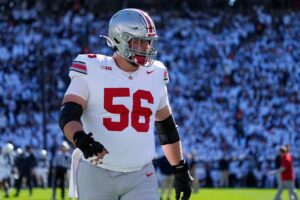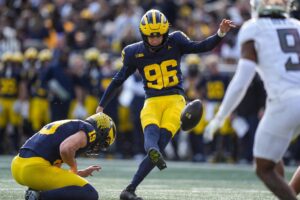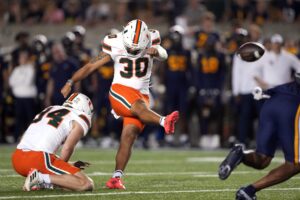Can Reeling Mountaineers Find Footing?
Through four games, many in the college football world seemed high in the 2021 West Virginia Mountaineers despite their 2-2 record. A turnover-ridden but close loss to Maryland to open the season was not ideal, but opening-game hiccups happen. A home win over ranked rival Virginia Tech helped their case. They brought that momentum into Norman and lost in heartbreaking fashion after a valiant effort. In the two games since, however, West Virginia has shown only fleeting signs of life. Things certainly came crashing down in a big way during a road blowout against Baylor. Now, fans rightly ask, can reeling Mountaineers find footing after their bye week?
Defense Isn’t Enough
Simply, the Mountaineers rely far too heavily on their defense. The unit features plenty of players who contribute upper-level talent. Akheem Mesidor and Dante Stills, for example, continue to play at an All-Conference level. At what point, though, do they tire of shouldering the burden?
We have seen it later in games where they give up several successive chunk plays despite no change in personnel or scheme. The defense holds strong for multiple drives, the offense fails to capitalize, and then the defense shows a few chinks in the armor. Then, we have Baylor. The Bears capitalized on Scottie Young’s absence and the Mountaineers’ focus on preventing deep throws. They shredded a unit that did itself no favors by losing receivers in coverage holes time and time again.
Even good defenses, however, have off days. The Baylor game proved this unequivocally. Unfortunately, without an offense capable of putting quick points on the board, any game with a three-score spread seems completely out of reach. Simply, that’s what the Mountaineers’ trip to Waco felt like. They got behind early, and everyone knew: this one was over.
Though we can point a lot of fingers at defensive ineptitude through Dana Holgorsen‘s tenure, it rarely ever felt like a game was completely out of reach. Why? Because the offense could almost always score in bunches. A turnover or two could turn into a 21-point swing in less than a quarter.
So Where is the Offense?
What has the offense looked like under Head Coach Neal Brown? There is not really a delicate way to put it, but it has not looked good. The team averages 21.5 points per game against Power Five opponents during Brown’s tenure. By comparison, the Mountaineers averaged 32.9 under Holgorsen. This does not mean that we look back at Holgorsen fondly. He was, without doubt, an offensive-minded coach, but he had plenty of shortcomings. It causes us to ask, however, what gives here?
It is not like Brown has been unable to lead offenses to points elsewhere in his career. His teams at Troy averaged 31 points a game during his four-year tenure. Texas Tech averaged 34.8 points per game during his three-year stint as offensive coordinator in Lubbock. Again, we must ask, where is the offense?
What Brown Inherited
Regardless of how any of us feel about what has transpired since (and we share our thoughts below), Brown did not inherit much production in his first year in Morgantown. He retained all of West Virginia’s rushing yards. The passing game and offensive line, however, were gutted. Will Grier graduated. As a result, Brown lost 92% of the quarterback production from 2018.
Of the wide receivers and tight ends registering receiving yards in 2018, only T.J. Simmons, Jovanni Haskins, and Sam James returned. Those two position groups accounted for 3,638 receiving yards. Simmons, Haskins, and James combined for 491 of those yards. Thus, Brown lost 87% of the team’s receiving production.
On the offensive line, Brown lost almost the entire starting unit. Indeed, of the top five offensive linemen in 2018, only one–Colton McKivitz–returned to contribute significantly to West Virginia in 2019. (Josh Sills returned in 2019 as well, but he elected to transfer out after getting injured early in the season. He played just two games that season.) Two backups with less than 600 combined snaps–Chase Behrndt and Kelby Wickline–took on expanded starting roles for the first time in their careers in 2019. In total, Brown lost nearly 68% of the offensive line production from 2018.
In all, Coach Brown only inherited one player who has been drafted to date, Behrndt. There are likely two to three more inherited players who will hear their names called in the NFL draft this year or next. That said, this also speaks volumes as to how young the team was that Brown inherited.
Offensive Line Woes
The offensive line, in fact, was the position group Brown pointed to first when evaluating his returning roster. He said it was the team’s biggest weakness. Unfortunately, through five games this season, that still seems to be the case. There are some reasons why. If you take the time to ask virtually anyone with experience coaching, playing, or scouting football players, they will all tell you that it takes three full years in a program, with some meaningful snaps, to consider an offensive lineman to be fully developed.
Indeed, while there is no magic number on returning snap count, the ideal world gives a coach at least three to four offensive linemen with at least 1,000 snaps of FBS experience, with two to three of those having at least two-and-a-half years worth of snaps (1,500 or more). Then, a coach can rely on the veteran leadership to help move the younger bodies along.
Simply, Brown has not yet had that benefit. This year, he still suffers. Going into the season, Brown only had one offensive lineman on the roster with over 1,000 FBS snaps: Doug Nester. Three more had more than 500: Zach Frazier (555), James Gmiter (826), and Brandon Yates (617).
Unfortunately, more than any other position on the field, the offensive line requires time to develop. The good news is this. Barring injury or transfer, West Virginia will return four players next season with more than 1,000 snaps, and two of those will have over 1,500 snaps. The bad news is that in-season improvement often comes in minute incremental steps. As a result, while we expected better play from this unit than they have given to date, we cannot realistically expect a massive jump in performance until next season.
Riding the Wrong Horse?
With that behind us, we continue to wonder what Brown was seeing when he called Jarret Doege the “most improved” player on the entire team this offseason. Again, we questioned this immediately. It is virtually unheard of to see a quarterback make a huge leap any time after his third year starting games at the FBS level. Doege is in his fifth. That said, we continued to hear it enough that the repetition made us wonder: could Brown be right?
We have seen nothing to support Brown’s praise. Doege does not run the RPO effectively; he does not scramble effectively. His bootleg plays are dead on arrival. When he dials up heavily scripted plays where the offensive line gives him time, Doege works efficiently. Once the script shifts or the play is broken, however, Doege struggles.
As discussed above, the fact is the offensive line has been and will likely continue to be inconsistent, at least for this season. As such, we do not see how Doege offers the best option. Can the reeling Mountaineers find a footing? We believe they can, to some extent; but that will require testing out a fresh quarterback, Garrett Greene, who can at least mask pass protection issues with his legs.
Doege’s numbers in prior seasons, by the way, have been defended by many because the young Mountaineers receivers have been guilty of so many drops. That is not the case this season. They have dropped some passes, but the numbers are on pace to be less than half of those of last season. And not to pile on here, but Doege’s record at Bowling Green was 4-15. We simply don’t understand the staff’s allure with Doege to this point.
[pickup_prop id=”10811″]
Please Use Your Other Backs
This may seem counter-intuitive considering the offensive line issues discussed above. That said, we will continue to pound this drum. Brown needs to spread the wealth in the run game. Leddie Brown is a special running back. His best quality remains his shiftiness and ability to pile on yards after contact. That said, he currently sees the field on more than 95% of the Mountaineers’ offensive snaps. Breaking tackles and absorbing the punishment of his position takes a big toll on the body.
The team needs Brown fresh late into games and late into this season. The very best way to do that is to rotate second- and third-quarter snaps with your other running backs. Tony Mathis and Justin Johnson offer immediate solutions. In limited play, Johnson, in particular, has looked very good at times. It is time to give him some more work.
In sum, to answer the question “can the reeling Mountaineers find footing,” we offer several simple solutions. Play your dual-threat quarterback more often, and open more of the offense to him. Call plays for him that allow him to release the ball quickly to mask the line’s inconsistencies. Then, give Brown’s legs a rest from time to time by putting some miles on Mathis and Johnson. Finally, whatever issues are causing the team confusion getting into the right sets, needs to stop.
If the team can manage to build some momentum to end this season, then we do believe the incoming recruits can inject even more energy into the program. Then, we can start talking about things like whether a dedicated play-calling offensive coordinator could help take things to the next level.






